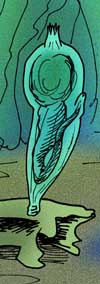Phlogites
Appearance
| Phlogites Temporal range:
| |
|---|---|

| |
| Reconstruction of Phlogites | |
| Scientific classification | |
| Domain: | Eukaryota |
| Kingdom: | Animalia |
| Superphylum: | Deuterostomia |
| Stem group: | Ambulacraria |
| Clade: | †Cambroernida |
| Genus: | †Phlogites Shu et al. 2001 |
| Species: | †P. longus
|
| Binomial name | |
| †Phlogites longus | |
| Synonyms | |
| |
Phlogites, a senior synonym of Cheungkongella ancestralis,[1] is a cambroernid, and thus a member of the deuterostome total group. It is known from the Lower Cambrian Haikou Chengjiang deposits of China, and was initially compared to the tunicates.[2] It was originally described as a tunicate, though, this identification has been questioned, especially with the discovery of another Chengjiang tunicate, Shankouclava. This challenge to Cheungkongella being a tunicate has led some experts to reassess it as a cambroernid related to Eldonia, Herpetogaster, and most closely to Phlogites, to which it has been subjectively synonymized as.
References
- ^ @article{Hou2006g, title = {The Template:Lower Cambrian {{{\emph{Phlogites}}}} Template:Luo \& Template:Hu Re-Considered}, author = {Hou, Xian-Guang and Bergstr{\"o}m, Jan and Ma, Xiao-Ya and Jie, Z}, year = {2006}, journal = {GFF}, volume = {128}, pages = {47--51} }
- ^ Shu, X. L.; Chen, D. G.; Han, X. -L.; Zhang, X. -L. (24 May 2001). "An Early Cambrian tunicate from China". Nature. 411 (6836): 472–473. doi:10.1038/35078069. PMID 11373678.
